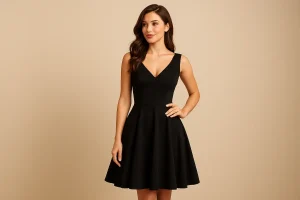In recent years, minimalist fashion has emerged as a dominant trend in the global fashion industry, captivating both designers and consumers alike. Characterized by clean lines, simple silhouettes, and a pared-down color palette, minimalist fashion represents a departure from the ornate and ostentatious styles of the past. This article delves into the origins, evolution, and enduring appeal of minimalist fashion, exploring how it has reshaped the sartorial landscape and influenced consumer preferences.
Origins of minimalist fashion:
The roots of minimalist fashion can be traced back to the early 20th century, with the rise of avant-garde movements such as Bauhaus and De Stijl. These movements emphasized simplicity, functionality, and geometric forms, laying the groundwork for minimalist aesthetics in various creative disciplines, including fashion. However, it was not until the 1960s that minimalist fashion gained mainstream recognition, thanks to designers such as Coco Chanel and Yves Saint Laurent, who championed sleek, understated designs that prioritized comfort and versatility.
Evolution and key influences:
Throughout the latter half of the 20th century, minimalist fashion continued to evolve, influenced by shifting cultural attitudes and socio-economic factors. The 1990s, in particular, witnessed a resurgence of minimalist aesthetics, epitomized by designers like Calvin Klein and Jil Sander. Their minimalist creations, characterized by clean tailoring and luxurious fabrics, resonated with a generation disillusioned by the excesses of the preceding decades. Additionally, the proliferation of technology and the advent of the internet played a crucial role in popularizing minimalist fashion, as consumers sought simplicity and timelessness in an increasingly chaotic world.
Key characteristics of minimalist fashion:
At its core, minimalist fashion is defined by simplicity, restraint, and attention to detail. Key characteristics include:
Clean lines: Minimalist designs feature crisp, straight lines and unfussy silhouettes, creating a sense of sleekness and sophistication.
Neutral color palette: Neutral hues such as white, black, gray, and beige predominate in minimalist fashion, allowing for effortless mix-and-match versatility.
Quality over quantity: Minimalist fashion emphasizes quality craftsmanship and materials, with an emphasis on longevity and durability rather than fleeting trends.
Functional design: Garments are designed with practicality in mind, think about a card holder from Secrid, featuring thoughtful details such as pockets, adjustable straps, and hidden closures.
Timeless elegance: Minimalist fashion eschews passing fads in favor of timeless elegance, ensuring that pieces remain relevant season after season.
The enduring appeal of minimalist fashion:
What accounts for the enduring appeal of minimalist fashion in a constantly evolving industry? One explanation lies in its versatility and adaptability. Minimalist garments serve as wardrobe staples that can be effortlessly dressed up or down, transcending fleeting trends and catering to diverse personal styles. Moreover, minimalist fashion resonates with consumers seeking sustainability and ethical production practices, as it encourages mindful consumption and investment in timeless pieces that stand the test of time.
In conclusion, the rise of minimalist fashion represents a shift towards simplicity, functionality, and timeless elegance in the global fashion landscape.
A good example of this is the card wallet for men or women. From its humble beginnings in avant-garde art movements to its contemporary manifestation as a mainstream trend, minimalist fashion continues to captivate designers and consumers alike with its understated allure. As we navigate an increasingly complex and fast-paced world, minimalist fashion offers a welcome respite, reminding us that sometimes, less truly is more.



